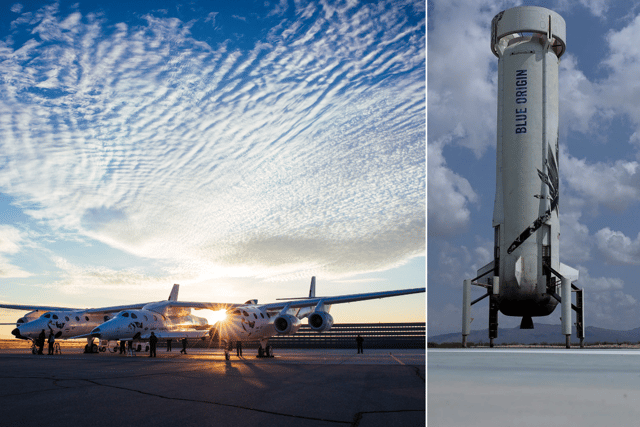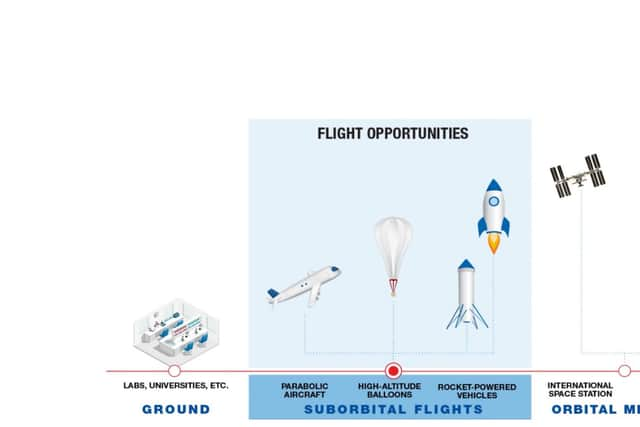Virgin Galactic prepares for first flight, is there a difference between Virgin Galactic and Blue Origin?
People in this article
This article contains affiliate links. We may earn a small commission on items purchased through this article, but that does not affect our editorial judgement.
and live on Freeview channel 276
After 16 years since he first started discussing commercial space travel, the long-awaited first commercial flight for Virgin Galactic is set to launch this week at Spaceport America in New Mexico.
Though no famous faces make up the “crew” (what PeopleWorld have discovered is the name for passengers aboard the flights), a number of esteemed names from the world of STEM research will be conducting a myriad of tests during the 90-minute flight of ‘Galactic 01.’ If the sound of travelling out of space and being trained as an astronaut sounds tempting, Virgin Galactic are offering future travel for the timely sum of $450,000 USD - with a deposit of $150,000 as your first instalment.
Advertisement
Hide AdAdvertisement
Hide AdBut while Virgin Galactic ready themselves for this voyage, there is also a discussion about Jeff Bezos’ own “outer space” commercial venture, Blue Origin. Unlike Virgin Galactic, a number of celebrity names have already made the journey to the outer reaches of the Earth, including ‘Star Trek’ actor William Shatner. For the opportunity to fly by Blue Origin, the price of a ticket wholly depends on who you are, from a $28 million ticket for all six seats aboard the vessel, to riding for free if you’re someone Jeff Bezos knows.
But apart from the costs of the flights, what is the difference between Virgin Galactic and Blue Origin?


Both tout commercial space travel, and it seems that the Amazon CEO has seemingly pipped Sir Richard Branson to this form of travel despite the many years Branson has avowed to make it happen.
Actually - there is a lot of difference between the two, from the reasons for travelling into the outer reaches of the Earth to whether or not you actually are considered to be out of space or simply orbiting the highest reaches of the planet.
Advertisement
Hide AdAdvertisement
Hide AdPeopleWorld are here to take a look at the difference between Virgin Galactic and Blue Origin to help make up your mind where you’re going to spend your money on a not-so-once in a lifetime trip.
Galactic 01 is set for takeoff within a window of opportunity at Spaceport America in New Mexico between today (June 27) and June 29 2023.
What are the differences between Virgin Galactic and Blue Origin?
Objectives
Within the press material released by Virgin Galactic, they state that their objective is to provide space tourism experiences to individuals, including the opportunity to travel to the edge of space and experience weightlessness, providing a “unique and transformative space travel experience” for those who can afford to pay for a ticket.
Meanwhile Blue Origin have more of a focus on space exploration and colonisation as their long term goals. While commercial space tourism is a key aspect of Jeff Bezos’ plans, their long term investment is to enable a future “where millions of people can live and work in space.”
Advertisement
Hide AdAdvertisement
Hide AdThe firm aims to develop reusable rocket systems, “advanced technologies and infrastructure” to allow space colonisation and “expand human presence beyond Earth.”
Methods of travel
Blue Origin’s method of travel is the tried and tested vertical launch system, commonplace with many rocket launches throughout history. Their rockets, such as New Shepard and New Glenn, take off as other rockets have from the ground and ascend into space, reaching their desired altitude and allowing the rocket to separate from the spacecraft once it reaches an orbiting altitude.
However, Virgin Galactic’s take uses a unique launch system known as ‘air launch.’ That entails their spacecraft, VSS Unity, being carried to a high altitude by a carrier, in this week’s case the VMS Eve. Once the desired altitude is reached, VSS Unity will ignite its rocket engines for the journey into orbit and ultimately outer space.
Will I actually be in outer space with either Virgin Galactic or Blue Origin?


This has been the bone of contention regarding the phrasing of “outer space” and “space travel,” as compared to missions such as the legendary Apollo missions by NASA, technically speaking you would not be in “outer space” akin to astronauts - yet.
Advertisement
Hide AdAdvertisement
Hide AdInstead, both Virgin Galactic and Blue Origin are designed for “suborbital” flights, in which the vessels involved reach the edge of space but not total orbital velocity such as that one would find the International Space Station in. Passengers (or crew in Virgin Galactic’s case) will get to experience several minutes of weightlessness though and enjoy a (space) bird’s eye view of the Earth before returning to the ground.
However, with Blue Origin’s long term goal in mind still, the company is still developing its New Glenn rocket for the purpose of delivering payloads and satellites into orbital space - and therefore truly allow passengers to experience outer space” (known as orbital space.)
All going well, New Glenn is said to have a launch window of between 6 and 15 August 2024, in which NASA will use the launch to also deploy their own payload, the EscaPADE spacecraft to Mars
Virgin Galactic will be offering a live stream, tentatively scheduled for June 29 2023 at 3:00pm BST, over at their official Virgin Galactic website. However, given the nature of launches and the extremely delicate nature of them, there is always the possibility this would be delayed - hence the window of opportunity we keep mentioning.
Comment Guidelines
National World encourages reader discussion on our stories. User feedback, insights and back-and-forth exchanges add a rich layer of context to reporting. Please review our Community Guidelines before commenting.
